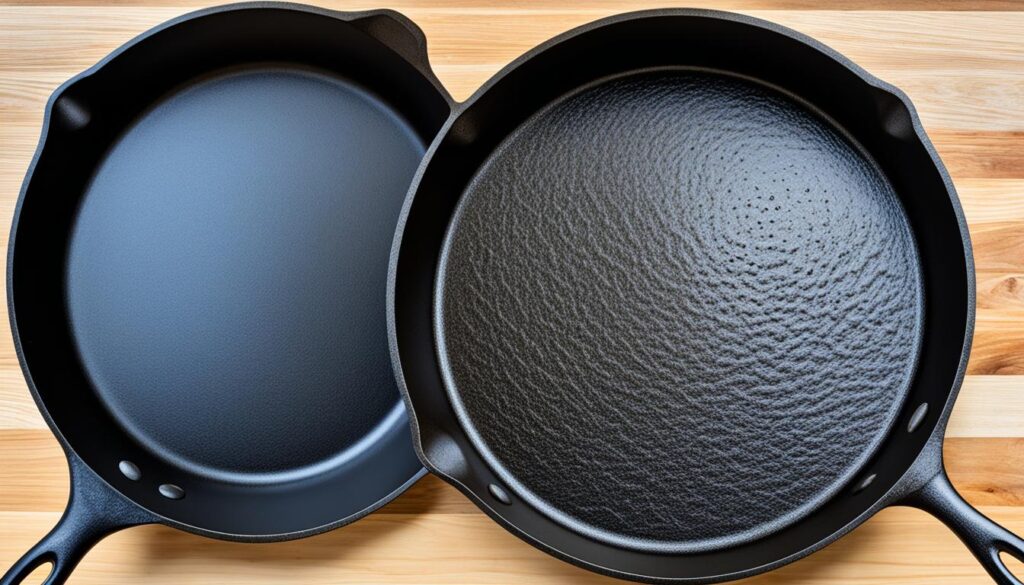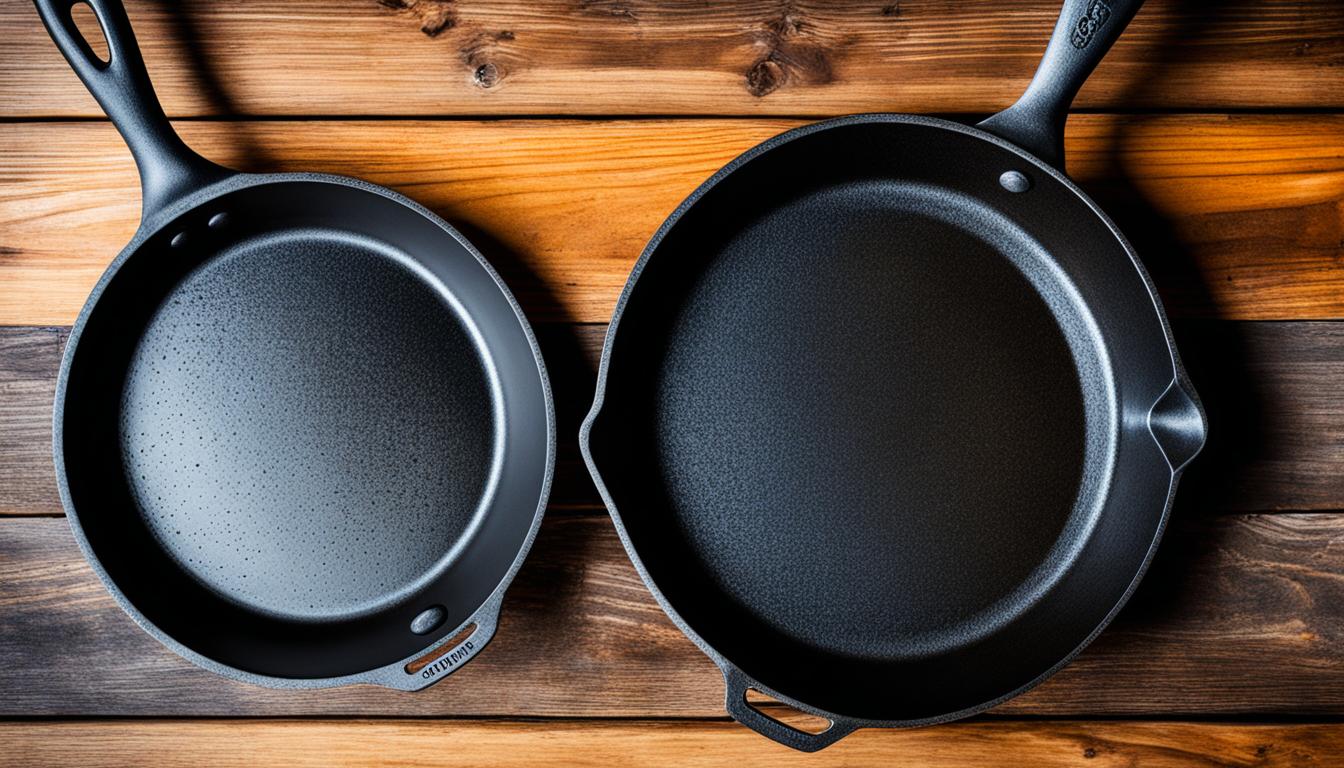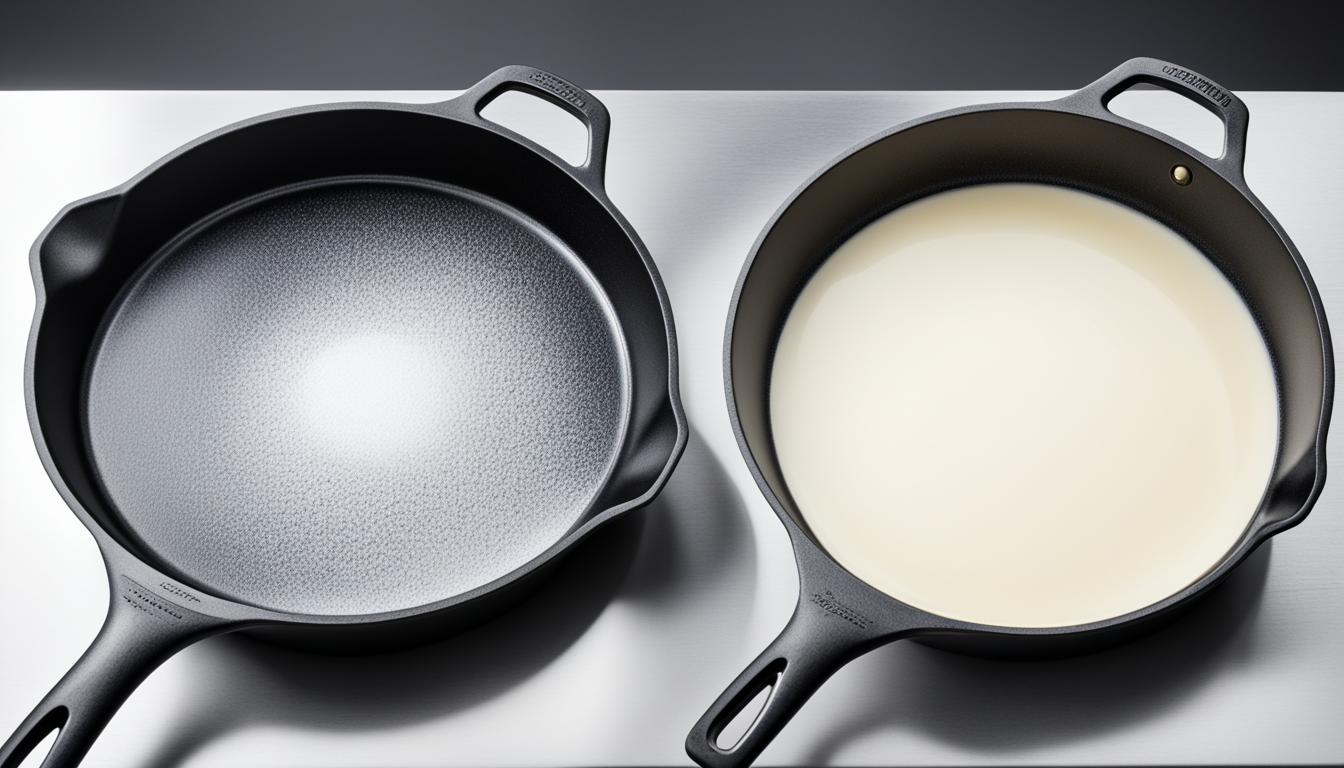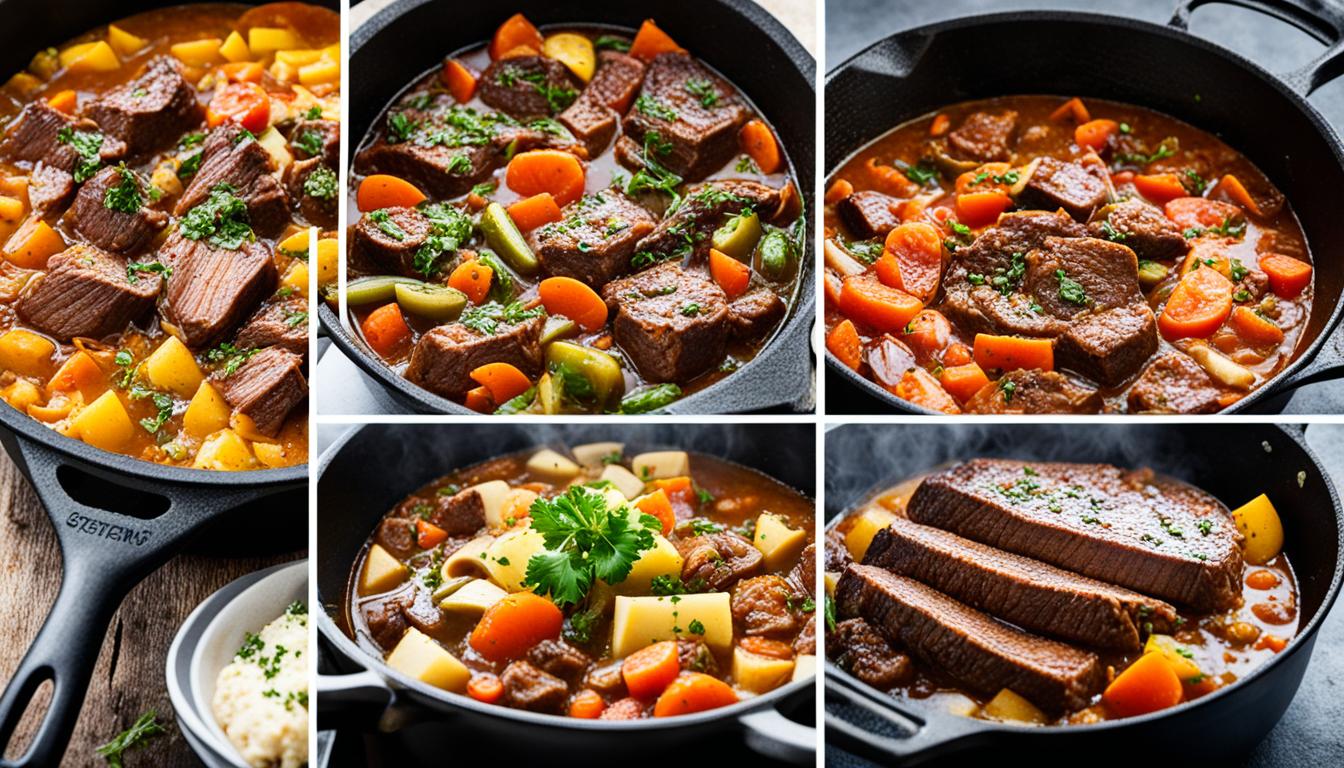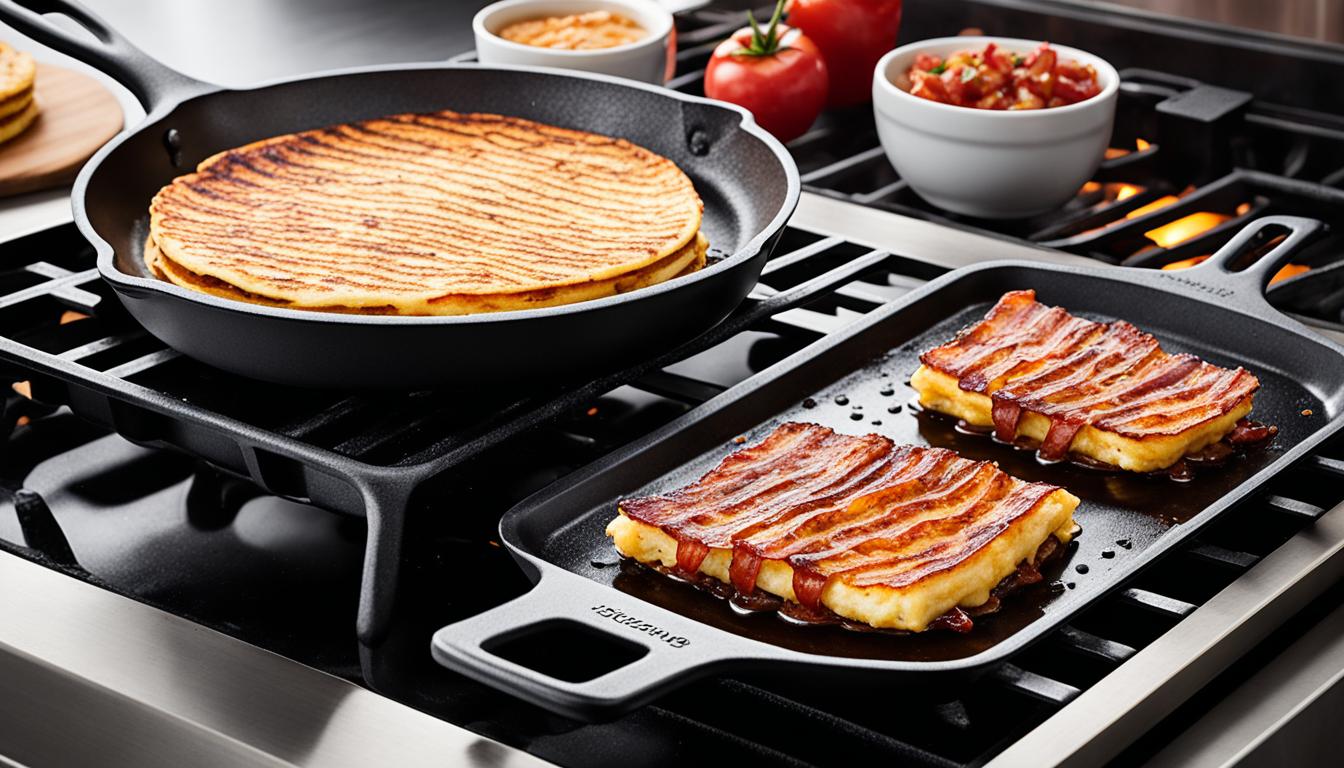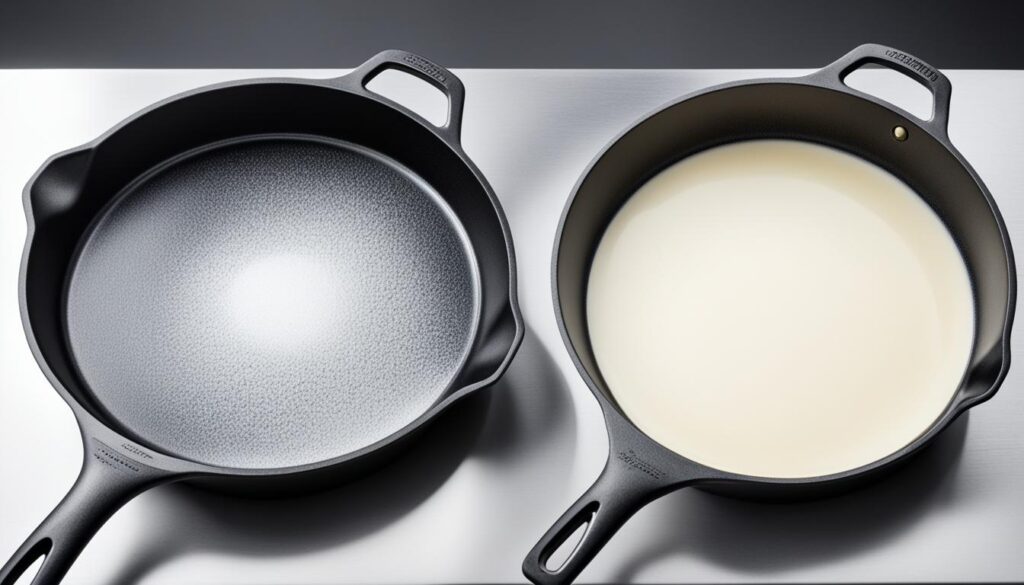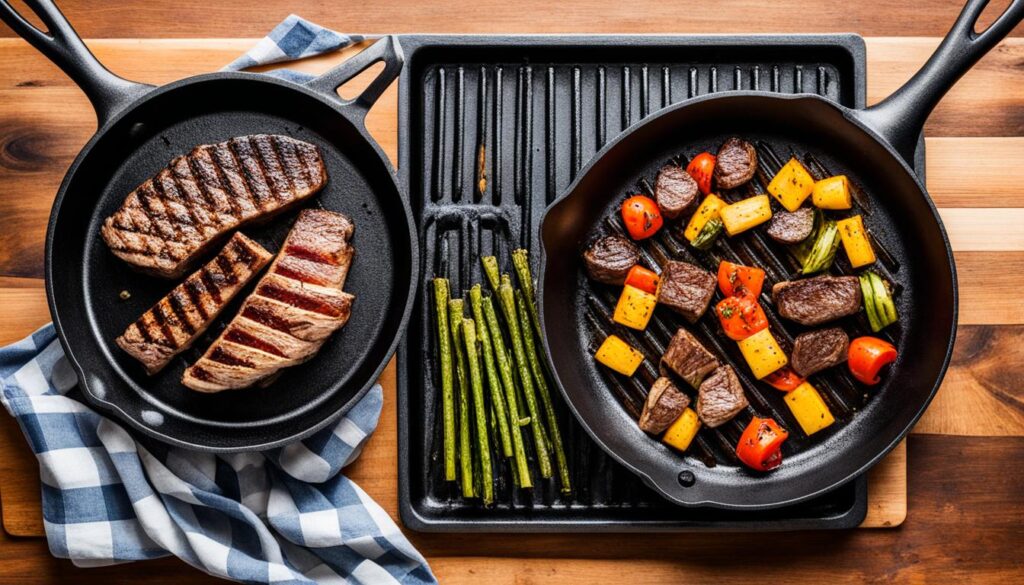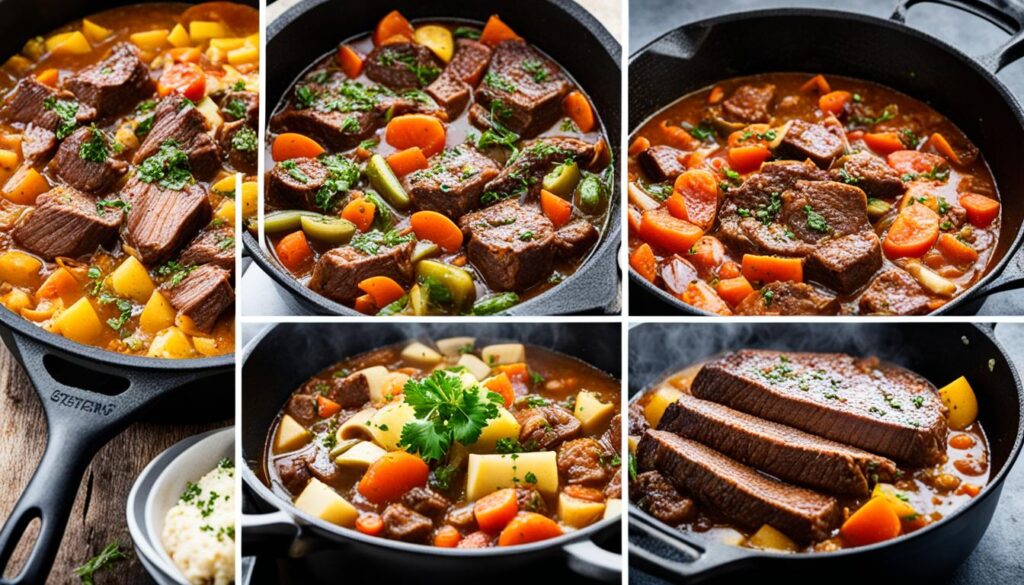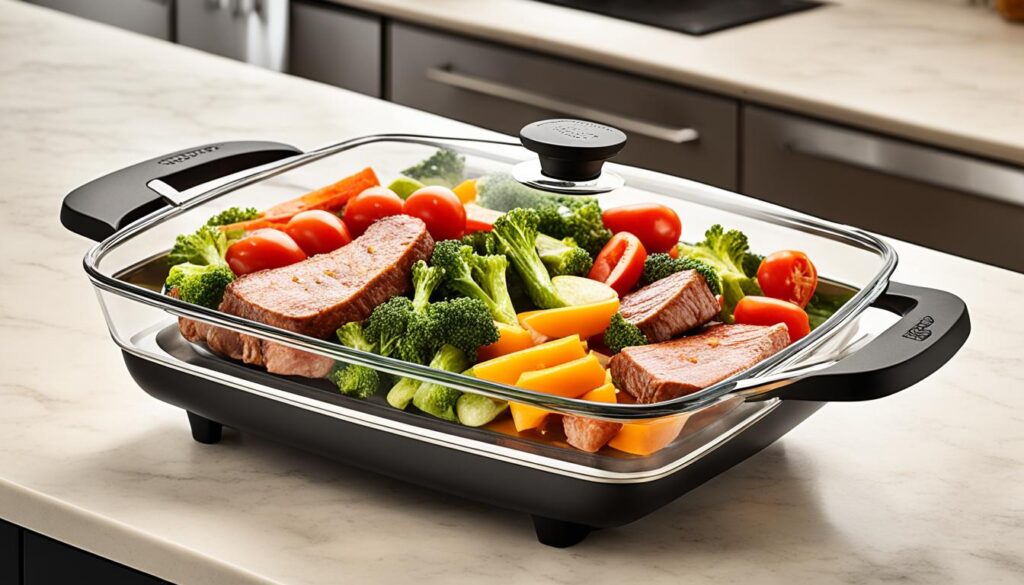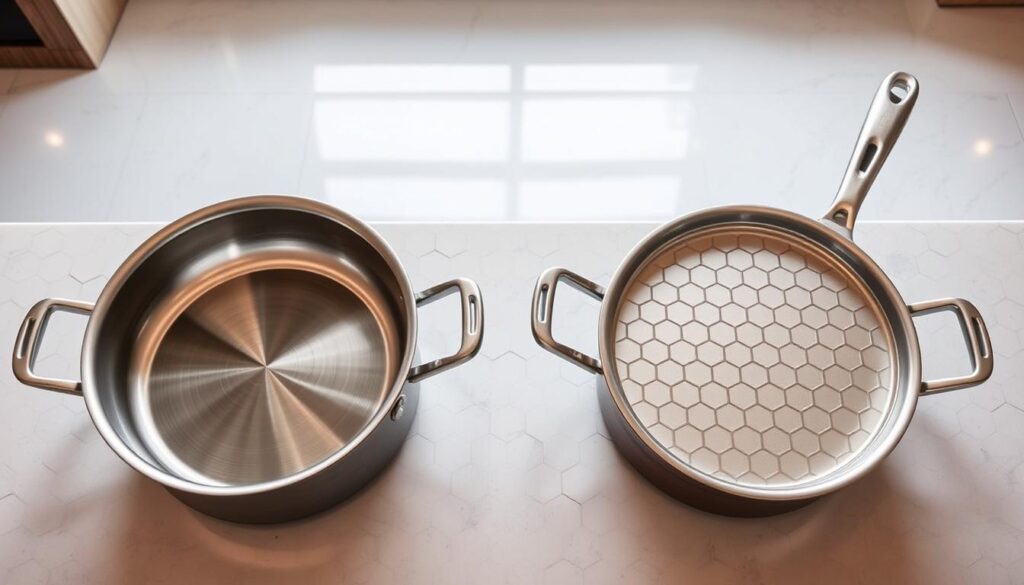Have you ever stood in the cookware aisle, unsure if you should pick a cast iron skillet or a non-stick pan? It’s a hard choice, I know. I love cooking and have tried many kitchen tools over the years. I’m here to guide you through this tough choice.
In cookware talks, cast iron and Teflon are often compared. Both have good points, but which is best for you? We’ll look at the pros and cons of these cooking wonders.
We’re going to talk about everything. From how long they last to what’s best for your health. It doesn’t matter if you’re a new cook or a seasoned chef. Knowing the differences helps you make the best choices in your cooking adventures.
Key Takeaways
- Cast iron skillets and Teflon pans each have unique cooking properties
- Durability varies significantly between the two types of cookware
- Health considerations play a role in choosing between cast iron and non-stick
- Maintenance requirements differ for cast iron and Teflon surfaces
- Cost and long-term value are important factors in the decision-making process
- Both types of cookware offer different levels of versatility in the kitchen
Table of Contents
- 1 Introduction to Kitchen Cookware Showdown
- 2 The Basics of Non-Stick and Cast Iron Cookware
- 3 Heat Distribution and Cooking Performance
- 4 Durability and Longevity Comparison
- 5 Versatility in Cooking Methods and Recipes
- 6 Cast Iron Skillet vs Teflon: Health and Safety Considerations
- 7 Maintenance and Care Requirements
- 8 Cost Analysis: Initial Investment and Long-Term Value
- 9 Environmental Impact and Sustainability
- 10 Making the Right Choice for Your Kitchen Needs
Introduction to Kitchen Cookware Showdown
Choosing between non-stick and cast-iron cookware is a key decision. It can change how your meals turn out. After lots of cooking experience, I’m eager to give you my take on these cookware types.
Non-stick and cast-iron pans both shine in their own ways. Let’s see what each type does best:
- Non-stick cookware:
- Requires less oil for cooking
- Easy to clean
- Ideal for delicate foods like eggs and fish
- Cast-iron cookware:
- Excellent heat retention
- Versatile for stovetop and oven use
- Adds dietary iron to food
Your choice in cookware affects not only your dishes but also how you cook and care for them. For instance, a cast-iron skillet is unmatched when it comes to creating a Chicago-style deep dish. It gives that perfect crunch we all crave.

| Feature | Non-Stick | Cast-Iron |
|---|---|---|
| Heat Distribution | Even, but less heat retention | Takes longer to heat, but retains heat well |
| Durability | 2-5 years with proper care | Can last generations |
| Maintenance | Easy to clean, avoid metal utensils | Requires seasoning, can use metal utensils |
| Versatility | Limited to low-medium heat cooking | Suitable for high-heat cooking and baking |
Join us to learn more about these cookware differences and what they mean for your cooking. Whether you cook often or just now and then, grasping these differences will guide you to the best choices for your kitchen.
The Basics of Non-Stick and Cast Iron Cookware
In cookware, non-stick and cast iron are very popular. They each have special qualities. Knowing about them will help you use them better in your kitchen.
What is Non-Stick Cookware?
Non-stick cookware has a special coating, like Teflon. It stops food from sticking to the pan. This makes cooking and cleaning much easier. It’s ideal for stir-fry dishes and more.
- Requires little to no oil for cooking
- Ideal for delicate foods like eggs and fish
- Easy to clean
Understanding Cast Iron Skillets
Cast iron skillets are made from pouring melted iron into molds. They are great at keeping heat evenly. Seasoning makes them naturally non-stick over time.
- Versatile for stovetop, oven, and even campfire cooking
- Get better with use
- Can last for many years if cared for
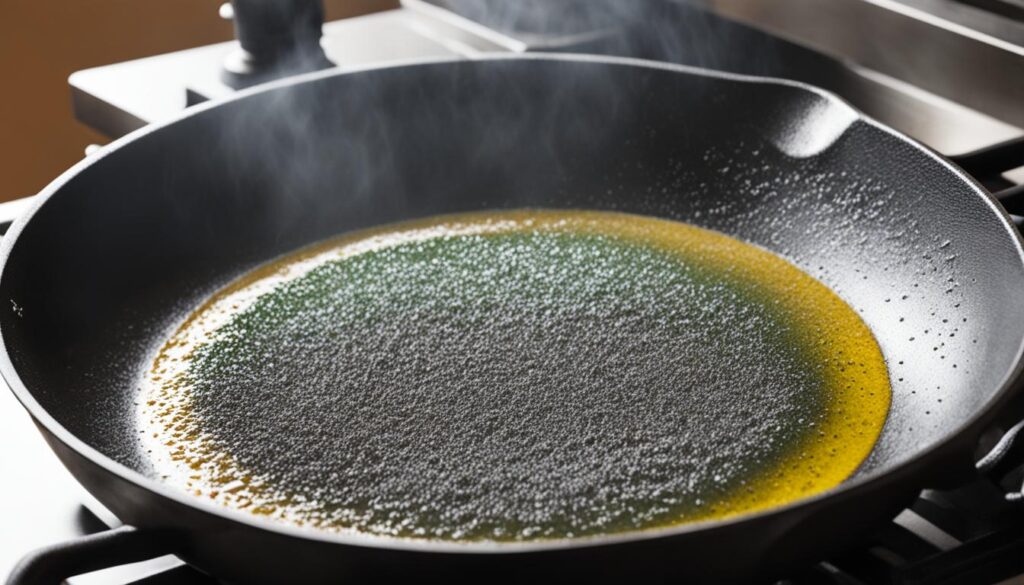
The Science Behind Non-Stick Coatings
Non-stick coatings work through their chemistry. PTFE coating creates a barrier that keeps water and oil away. This stops food from sticking. It’s a big help in the kitchen.
Choosing between non-stick and cast iron is about what you like and how you cook. Non-stick is easy, while cast iron is strong and can do a lot. Remembering these points will guide you to the best cookware for your kitchen.
Heat Distribution and Cooking Performance
In my kitchen adventures, I found heat distribution and cooking efficiency are key. Let’s look at how cast iron skillets and non-stick pans do in these areas.
Cast iron skillets keep heat really well. They take their time getting hot but then stay at a steady heat. This is great for cooking things like seared meats or foods that need a crispy edge, such as shrimp and broccoli stir-fry.
Non-stick pans, on the flip side, warm up fast and spread heat evenly. They’re good at keeping the right temperature. This works well for cooking fragile foods like eggs or fish precisely.
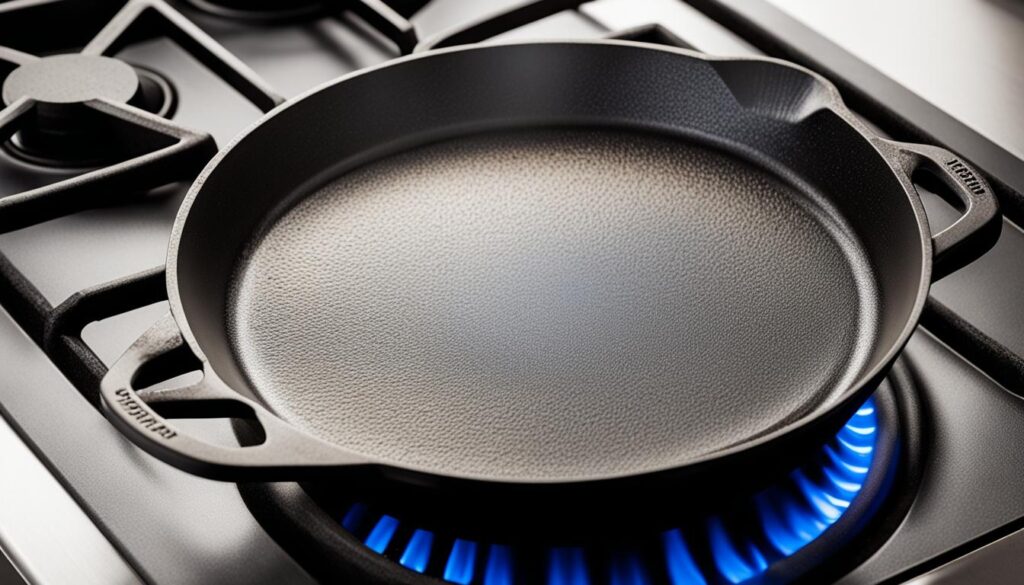
| Feature | Cast Iron Skillet | Non-Stick Pan |
|---|---|---|
| Heat-up Time | 5-6 minutes | 2-3 minutes |
| Heat Retention | Excellent | Fair |
| Even Heating | Good | Excellent |
| Temperature Control | Fair | Excellent |
| Best For | Searing, slow cooking | Delicate foods, quick cooking |
Both types have their own strengths in cooking. Cast iron saves energy during long cooking times, thanks to its great heat retention. Non-stick pans are best for quick cooking, making dishes like stir-fries faster and using less energy.
For an idea, let’s check the time for a common dish:
- Cast Iron: Shrimp and broccoli stir-fry takes about 10 minutes to cook
- Non-Stick: The same dish is ready in about 7-8 minutes
The best choice depends on what you like to cook and how you cook. Both cast iron and non-stick bring something special to making tasty meals.
Durability and Longevity Comparison
Non-stick pans and cast iron skillets fight it out for durability. I’ve checked out both to guide you in picking the best. You want kitchenware that lasts long.
Lifespan of Non-Stick Pans
Non-stick pans don’t last forever. Ceramic ones wear out in 1 to 3 years. PTFE types last up to 5 years. But, with the right care, non-stick pans can keep cooking for about 8 years.
Cast Iron Skillet Longevity
Cast iron skillets last and last if you look after them. They might even outlive you! Plus, if they rust, you can bring them back to life. This makes them a top pick for anyone wanting hardy kitchen gear.
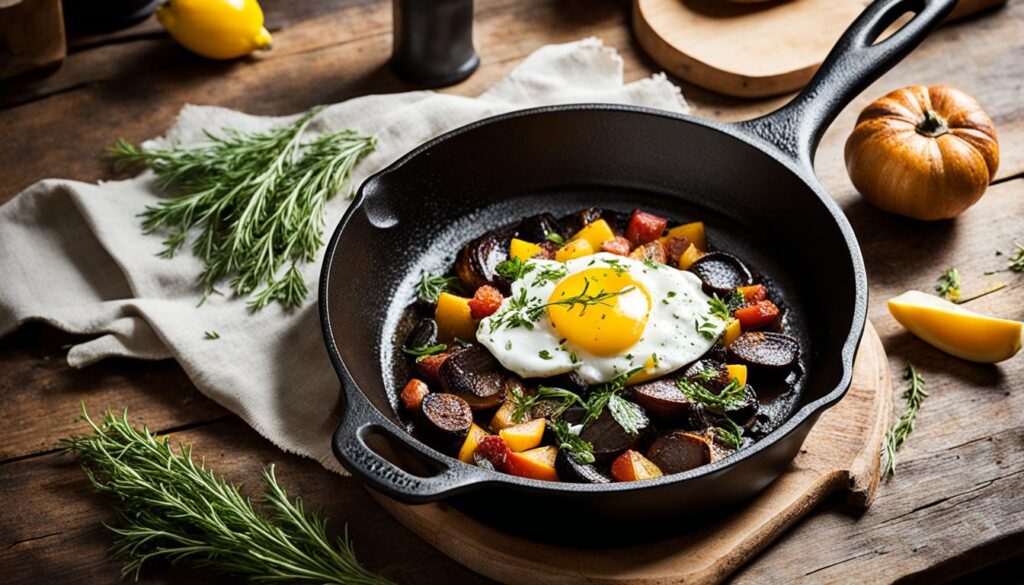
Maintenance Impact on Cookware Lifespan
How you care for cookware affects how long it lasts. Here are tips to keep your pots and pans in top shape:
- For cast iron: Rinse with hot water, dry thoroughly, and coat with neutral oil after drying
- For non-stick: Avoid using metal utensils and high heat
- For both: Hand wash and avoid soaking for extended periods
Seasoning is key for cast iron’s rust resistance and non-stick quality. For very rusty pans, season them 2-3 times before using. Check out more detailed maintenance tips for cast iron skillets.
| Cookware Type | Average Lifespan | Maintenance Level |
|---|---|---|
| Non-stick (Ceramic) | 1-3 years | Low |
| Non-stick (PTFE) | 3-5 years | Low to Medium |
| Cast Iron | Generations | Medium to High |
Non-stick pans are handy, but cast iron is unbeatable for lasting through time. Treat a cast iron skillet well, and it will serve your kitchen for years.
Versatility in Cooking Methods and Recipes
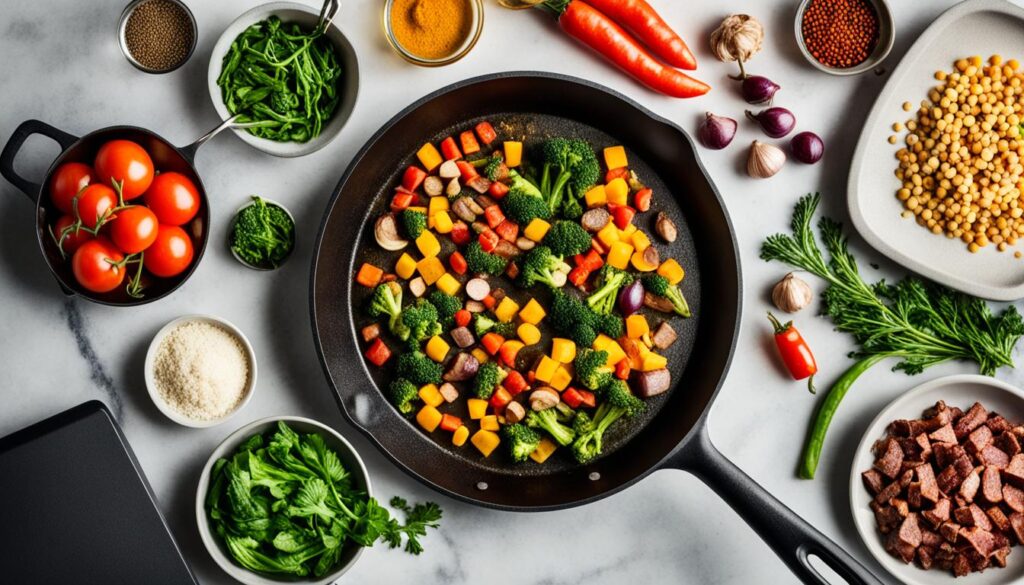
Non-stick and cast iron skillets have special uses in the kitchen. Each is good for different types of cooking, making them very versatile. We’ll look at the ways these skillets are used for cooking.
Non-stick pans are great for cooking fragile foods. They’re perfect for:
- Cooking eggs and omelets
- Sautéing vegetables
- Preparing delicate fish fillets
- Making crepes and pancakes
Cast iron skillets, meanwhile, can be used in many ways. They shine when:
- Searing meats at high temperatures
- Baking cornbread or skillet cookies
- Deep-frying chicken or potatoes
- Cooking over open flames while camping
For example, look at a simple skillet cookie recipe that both pans work well with:
- Preheat your oven to 350°F (175°C)
- Mix 1/2 cup (113g) melted butter, 1/3 cup (67g) brown sugar, and 1/4 cup (50g) white sugar
- Add 1 egg and 1 teaspoon vanilla extract
- Stir in 1 cup (125g) all-purpose flour and 1/2 teaspoon baking soda
- Fold in 1/2 cup (85g) chocolate chips
- Spread the dough in a 10-inch skillet
- Bake for 15-20 minutes until golden brown
Both skillets are good for this recipe. The cast iron might give the cookie a crispier edge. It’s also more durable, allowing the use of metal utensils. Non-stick skillets need careful use to protect their coating. Find more on seasoning cast iron skillets.
| Cookware Type | Best For | Limitations |
|---|---|---|
| Non-Stick | Low-fat cooking, delicate foods | High-heat searing, oven use above 500°F |
| Cast Iron | High-heat cooking, oven-to-table dishes | Acidic foods, quick temperature changes |
Cast iron is best for recipes that start on the stove and finish in the oven. But, non-stick pans are easier to clean and great for those watching their oil intake. Having both types of skillets prepares you for any meal you want to cook.
Cast Iron Skillet vs Teflon: Health and Safety Considerations
The safety debate between cast iron skillets and Teflon pans is ongoing. Let’s look at the facts so you can make an informed choice.
Non-Stick Coatings and Potential Health Risks
Teflon cookware has long been used in kitchens, but it’s not perfect. Even though newer Teflon pans are PFOA-free, there are still health worries:
- Pre-2013 Teflon may contain PFOA, linked to health issues
- Overheating Teflon can create toxic fumes
- It’s important to cook on low-to-medium heat
I always cook with non-stick pans over low-to-medium heat. It helps keep me safe from any harmful fumes.
Cast Iron and Dietary Iron Intake
Using cast iron skillets can help increase the iron in your diet. This is great for people who need more iron to avoid deficiency.
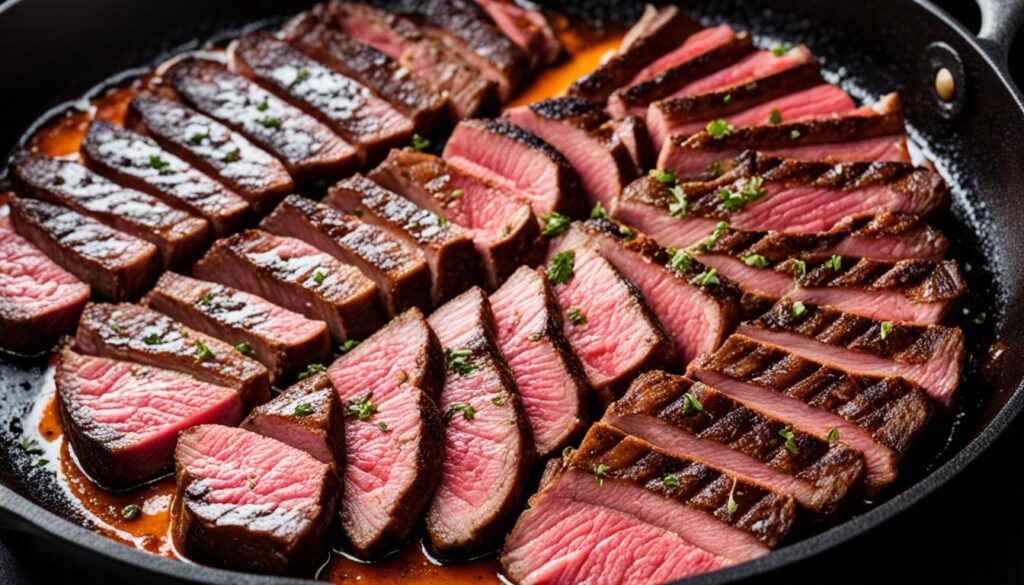
Searing meats and vegetables in my cast iron skillet helps boost my daily iron intake. Plus, it makes food taste great!
Safe Usage Temperatures for Both Types
Knowing the right temperatures for your cookware is very important:
| Cookware Type | Safe Temperature Range | Precautions |
|---|---|---|
| Teflon | Up to 500°F (260°C) | Avoid high heat, use proper ventilation |
| Cast Iron | Up to 700°F (371°C) | Use oven mitts, preheat gradually |
Sticking to the right cooking temperatures keeps your meals safe. It’s key to safe and healthy cooking, no matter the pan.
Maintenance and Care Requirements
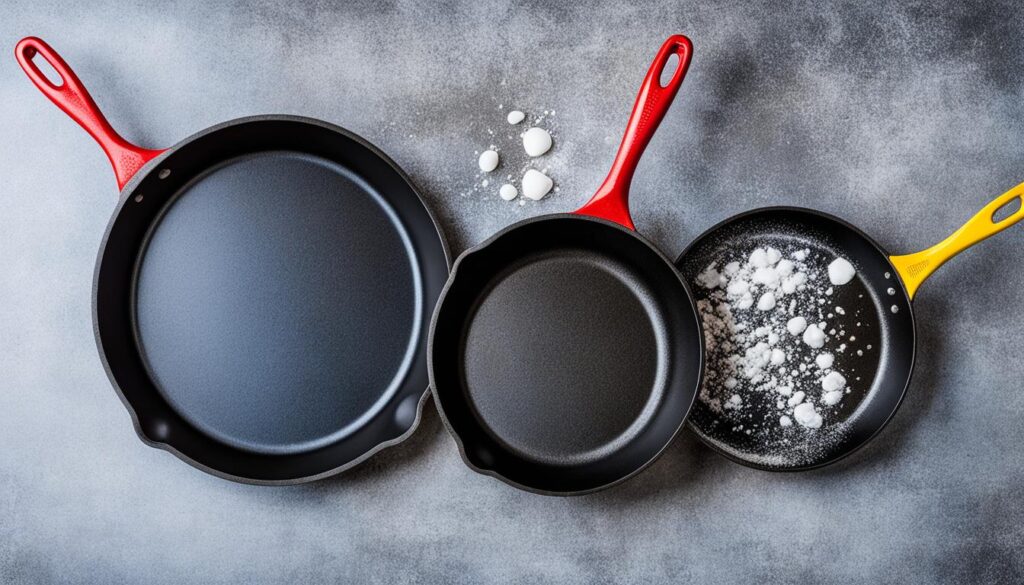
Keeping your cookware in top shape is vital for good cooking. I have tips for cleaning and caring for your pans to make them last longer.
First, treat non-stick pans gently:
- Wash with warm soapy water and a soft sponge
- Don’t use metal utensils as they can scratch the surface
- Avoid high heat, which might damage the coating
- Store carefully to prevent scratches
Now let’s discuss seasoning for cast iron. It creates a non-stick layer and prevents rust:
- Clean the pan thoroughly
- Apply a thin layer of oil all over the pan
- Bake at 450°F for 1 hour
- Allow to cool and then repeat 3-5 times for the best outcome
For general cast iron care, remember:
- Wash right after using with hot water and a brush
- Ensure it’s fully dry to stop rust
- Apply a thin oil coat after every use
Surprisingly, cast iron can last over 100 years with right care. It gets better with more use and proper care.
| Care Aspect | Non-Stick | Cast Iron |
|---|---|---|
| Cleaning Method | Gentle soap and soft sponge | Hot water and brush, use little soap |
| Drying | Air dry or use a soft towel | Ensure it’s completely dry |
| Maintenance | Keep away from high heat and metal utensils | Season it regularly |
| Lifespan | Can last 3-5 years with enough care | Lasts generations when properly treated |
Always keep in mind, looking after your cookware not only makes them last more. It also makes your cooking better. Enjoy cooking!
Cost Analysis: Initial Investment and Long-Term Value
Choosing between non-stick pans and cast iron skillets can seem hard. I’ve looked into both to help you pick one based on cost and value over time.
Price Range for Quality Non-Stick Pans
Non-stick pans are usually seen as more affordable. Good ones range from $20 to $100. But, premium brands can go up to $200.
Cost of Cast Iron Skillets
Cast iron skillets might cost more up front. A 10-inch skillet can be between $20 and $200. Le Creuset, a top brand, can be even pricier with its enameled pieces.
Long-Term Financial Considerations
Even though non-stick pans are cheaper at first, cast iron skillets win for value over time. They’re a better investment because:
- Durability: Cast iron skillets can last generations, unlike non-stick pans that need replacing every 3-5 years.
- Versatility: Cast iron works on many cooking surfaces, meaning you don’t need as many different pans.
- Health benefits: Cooking with cast iron can add iron to your food, which is good for health.
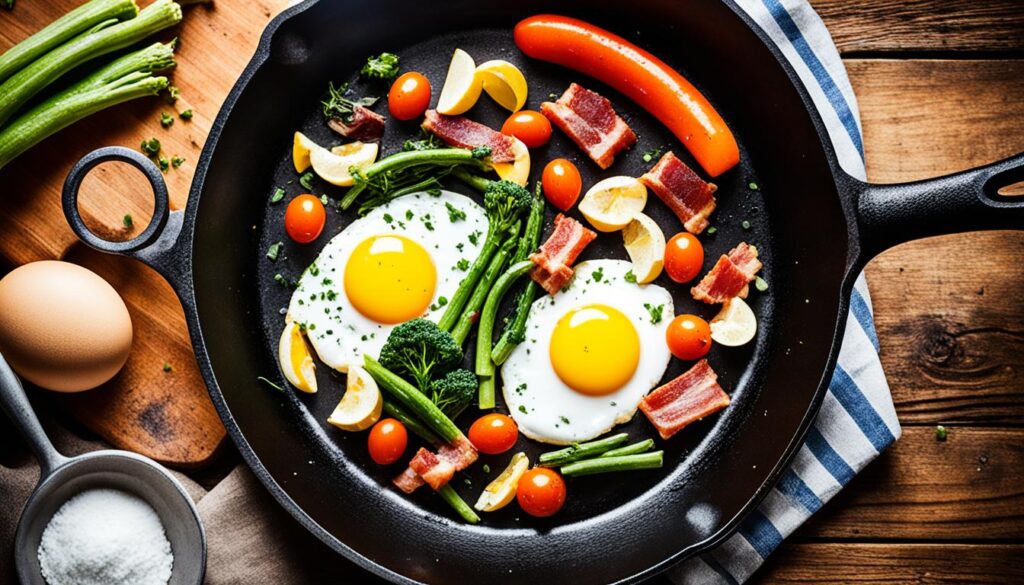
The cast iron cookware market hit $3002.98 million in 2023. It’s expected to grow to $3602.12 million by 2030. This shows more people are recognizing the long-term worth of cast iron.
Even though cast iron skillets cost more at first, they’re a better deal in the long term. By getting a good quality cast iron skillet, you’re not just getting cookware. You’re making a choice that will benefit your kitchen for years.
Environmental Impact and Sustainability
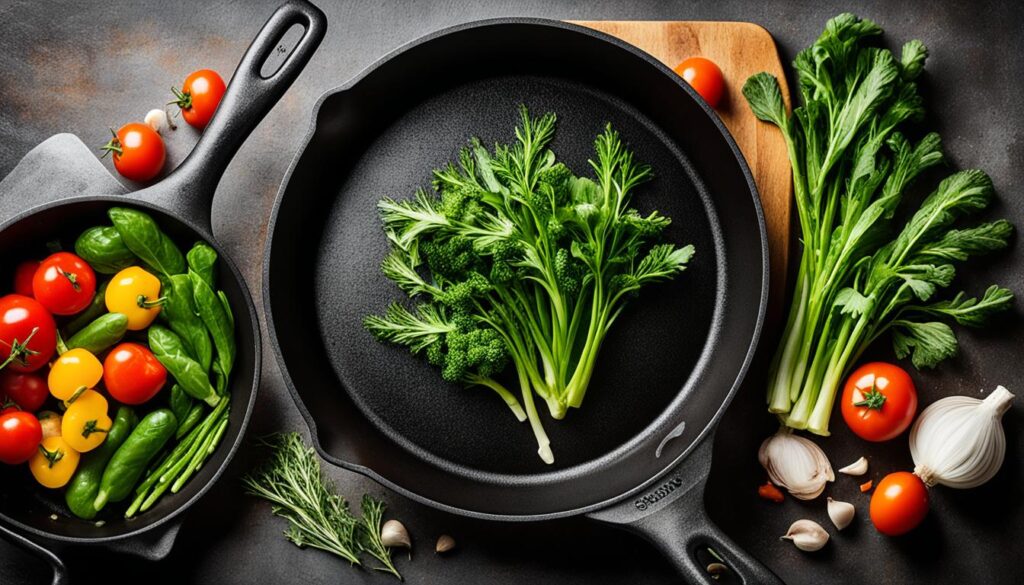
The choice between cast iron skillets and Teflon pans greatly matters for our world. I’ve looked into how both impact the environment. This will help you choose wisely.
Cast iron skillets are great for our planet. They can be used for many years, even passing down through families. Using them means you won’t need to buy new pans often, which helps reduce waste. Would you believe a good cast iron skillet can last for more than 100 years?
Now, Teflon pans don’t last as long, sadly. You might need a new one every three to five years. This means more pans get thrown out, making more waste. Also, making the non-stick coatings is not very earth-friendly.
Recyclability and Material Impact
Choosing cast iron is a good step for the environment. This is because you can recycle iron over and over. Making new pans from old ones also uses less energy. So, cast iron is a top pick for a green kitchen.
But, recycling Teflon pans is tricky. The chemicals in their coating can stay in the environment for a very long time. This might harm our water sources.
Energy Efficiency in Cooking
One cool thing about cast iron is how it keeps heat so well. This means you use less energy when cooking or warming food. So, it’s great for both the earth and your wallet.
- Cast iron requires less fuel for cooking
- Retains heat longer, reducing energy use
- Versatile for various cooking methods, minimizing the need for multiple pans
Though Teflon pans help use less oil, they don’t last long. This cancels out some of their green benefits. For a truly sustainable kitchen, choose cast iron. It lasts long, can be recycled, and saves energy.
Making the Right Choice for Your Kitchen Needs
Cookware selection depends on your cooking style. It’s important to consider non-stick and cast iron pans. If your cooking is light or you like low-fat dishes, non-stick pans are great. They help with easy foods and you can use less oil, which is healthy.
For those who enjoy high-heat cooking, cast iron is a must-have. Skottsberg has pre-seasoned pans that last a lifetime with proper care. These pans are safe and durable, being free of harmful chemicals.
Think about how you cook and what you’re willing to do to keep your pots and pans in good shape. Non-stick pans are a breeze to clean, but you’ll need new ones every year or so. Cast iron pans, on the other hand, last a really long time if you care for them well.
Cooking a variety, like recipes for arugula pesto or squash & cheddar tacos, helps figure out which pan suits you. The right choice of cookware can truly boost your cooking adventures. So, pick wisely according to what your kitchen demands.
